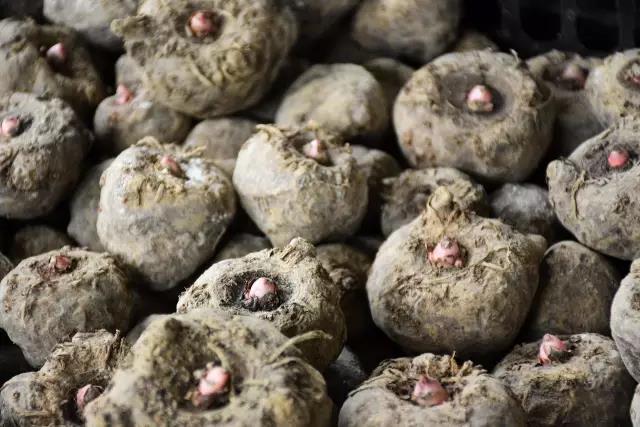
The focus is on the harvest, transportation and storage of taro plants. This is an important task for farmers who keep taro plants for next year’s konjac planting.
The harvest, transportation and storage of konjac
Harvest
After the frost, it is better to take advantage of the obvious signs of the plants on the ground and wait for more than 3 consecutive sunny days to dig again. After digging, the commodity taro can be immediately bagged or sold in baskets. Small bulbs and taro whips of less than 200g are reserved for planting taro in the coming year or sold as seed taro. Remove the soil and dry on the spot for about 3 days. After the surface moisture is dry, pick out the diseased stems and mechanically damaged taro. When loading the basket and transporting it back, you must handle it gently to avoid skin damage.
Wounded and diseased bulbs are not suitable for storage, and should be processed in time or concentrated and deeply buried.
transport
1. The transportation of commodity taro should mainly be timely in time. Because the konjac bulbs have high water content and are easy to rot or disease, the concentrated commodity taro should be sold or processed in time, and fresh taro should not be stored for a long time.
2. There are strict restrictions on the transportation of taro.
First of all, from the beginning of harvesting from the ground, planting taro must be selected and packed in baskets, and must not be completely filled, and an inch or so of space must be left to prevent squeezing. The size of the taro plants can be uniformly packed in baskets without grading, but the taro whips must be separately packed in separate baskets. Secondly, it must be handled quickly after loading the basket, and it should not exceed 72 hours from loading the basket, getting on the bus, and arriving at the destination. Third, the choice of transportation means must be clean, dry, odorless, and pollution-free. During transportation, pay attention to rain, sun, pollution, ventilation, and avoid squeezing to damage the packaging box; it must be opened and laid flat to dry immediately after reaching the destination. Finally, the whole process, from harvesting from the ground, to drying, loading baskets, and getting on and off the truck, are not allowed to violently collide, and must be handled with care to keep the taro skin intact.
Store
For growers, the storage of commercial taro is meaningless, unless it is stored after rough processing and drying, but there must be corresponding conditions.
The emphasis is on the storage of seed taro so that there will be planted taro for field production in the coming year. The following methods can be used for the storage of taro according to the actual situation.
Residential storage: In low-altitude areas with mild winter climate and no frost or slight frost, use 1-2 grade seed taro to reproduce fields with an incidence rate of less than 10%. It is not necessary to harvest the seed taro in the same year, and adopt residential storage. The method is: about 7 days after the natural fall of the konjac seedlings, the petiole is separated from the layer, the stalk is pulled out, the hole is sealed with soil, and the soil is covered with more than 5 cm of soil to safely survive the winter; the frozen soil layer exceeds 5 cm, and the 5 cm layer of soil can be covered. Sowing winter wheat or rapeseed and covering with a layer of soil can also prevent freezing damage.
Indoor storage: Before entering the indoor storage, you must choose fine weather and disinfect the taro. The disinfection can be quicklime + diniconazole, and the ratio is 1KG raw ash mixed with a bag of diniconazole carbendazim powder. Spread the seed taro thinly, and then evenly sprinkle the prepared powder on it, and then dry it for about a week to remove about 20% of the water from the seed taro. It can be installed halfway, and finally transferred to the room, stacked.
You can also use wooden racks for storage. Build wooden racks indoors and spread a thin layer of straw on the wooden racks to a thickness of about 10 cm. The stacking environment requires ventilation, anti-freezing, and keeping the indoor temperature not lower than 4°C. Check frequently throughout the storage period, pick out the diseased taro, and check it once every half a month.
In the coming year, around Qingming, the planting taro will wake up from dormancy and start to give birth to red young shoots, and you can start planting for a new round of production.
We welcome all experienced planting friends and experts to guide us and grow together.